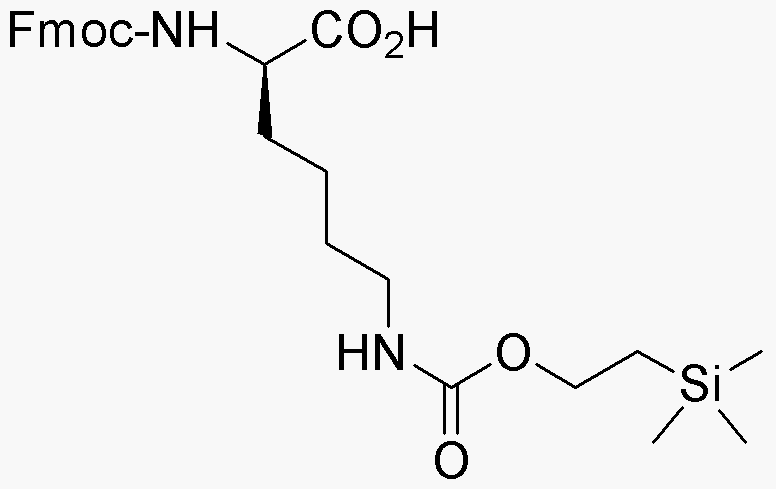Na-Fmoc-Ne-trimethylsilylethoxycarbonyl-D-lysine is widely utilized in research focused on:
- Peptide Synthesis: This compound serves as a protective group in the synthesis of peptides, allowing for the selective modification of amino acids without interfering with other functional groups. This is crucial for researchers developing complex peptides for therapeutic applications.
- Drug Development: It plays a significant role in the pharmaceutical industry, particularly in the design of peptide-based drugs. The ability to protect and deprotect specific amino acids enhances the efficiency of drug candidates, making them more viable for clinical use.
- Bioconjugation: The compound is used in bioconjugation processes, where it helps attach biomolecules to surfaces or other molecules. This is particularly beneficial in creating targeted drug delivery systems or diagnostic tools.
- Protein Engineering: Researchers utilize this chemical in protein engineering to modify lysine residues, which can improve protein stability and functionality. This is essential in developing enzymes or antibodies with enhanced properties.
- Research in Chemical Biology: It is a valuable tool in chemical biology for studying protein interactions and functions. By modifying lysine residues, scientists can investigate the role of specific amino acids in biological processes.
General Information
Properties
Safety and Regulations
Applications
Na-Fmoc-Ne-trimethylsilylethoxycarbonyl-D-lysine is widely utilized in research focused on:
- Peptide Synthesis: This compound serves as a protective group in the synthesis of peptides, allowing for the selective modification of amino acids without interfering with other functional groups. This is crucial for researchers developing complex peptides for therapeutic applications.
- Drug Development: It plays a significant role in the pharmaceutical industry, particularly in the design of peptide-based drugs. The ability to protect and deprotect specific amino acids enhances the efficiency of drug candidates, making them more viable for clinical use.
- Bioconjugation: The compound is used in bioconjugation processes, where it helps attach biomolecules to surfaces or other molecules. This is particularly beneficial in creating targeted drug delivery systems or diagnostic tools.
- Protein Engineering: Researchers utilize this chemical in protein engineering to modify lysine residues, which can improve protein stability and functionality. This is essential in developing enzymes or antibodies with enhanced properties.
- Research in Chemical Biology: It is a valuable tool in chemical biology for studying protein interactions and functions. By modifying lysine residues, scientists can investigate the role of specific amino acids in biological processes.
Documents
Safety Data Sheets (SDS)
The SDS provides comprehensive safety information on handling, storage, and disposal of the product.
Product Specification (PS)
The PS provides a comprehensive breakdown of the product’s properties, including chemical composition, physical state, purity, and storage requirements. It also details acceptable quality ranges and the product's intended applications.
Certificates of Analysis (COA)
Search for Certificates of Analysis (COA) by entering the products Lot Number. Lot and Batch Numbers can be found on a product’s label following the words ‘Lot’ or ‘Batch’.
*Catalog Number
*Lot Number
Certificates Of Origin (COO)
This COO confirms the country where the product was manufactured, and also details the materials and components used in it and whether it is derived from natural, synthetic, or other specific sources. This certificate may be required for customs, trade, and regulatory compliance.
*Catalog Number
*Lot Number
Safety Data Sheets (SDS)
The SDS provides comprehensive safety information on handling, storage, and disposal of the product.
DownloadProduct Specification (PS)
The PS provides a comprehensive breakdown of the product’s properties, including chemical composition, physical state, purity, and storage requirements. It also details acceptable quality ranges and the product's intended applications.
DownloadCertificates of Analysis (COA)
Search for Certificates of Analysis (COA) by entering the products Lot Number. Lot and Batch Numbers can be found on a product’s label following the words ‘Lot’ or ‘Batch’.
*Catalog Number
*Lot Number
Certificates Of Origin (COO)
This COO confirms the country where the product was manufactured, and also details the materials and components used in it and whether it is derived from natural, synthetic, or other specific sources. This certificate may be required for customs, trade, and regulatory compliance.


